 W
WAviation insurance is insurance coverage geared specifically to the operation of aircraft and the risks involved in aviation. Aviation insurance policies are distinctly different from those for other areas of transportation and tend to incorporate aviation terminology, as well as terminology, limits and clauses specific to aviation insurance.
 W
WA bird strike—sometimes called birdstrike, bird ingestion, bird hit, or bird aircraft strike hazard (BASH)—is a collision between an airborne animal and a moving vehicle, usually an aircraft. The term is also used for bird deaths resulting from collisions with structures such as power lines, towers and wind turbines.
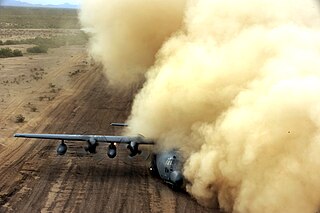 W
WIn aviation, a brownout is an in-flight visibility restriction due to dust or sand in the air. In a brownout, the pilot cannot see nearby objects which provide the outside visual references necessary to control the aircraft near the ground. This can cause spatial disorientation and loss of situational awareness leading to an accident. Pilots have compared landing during brownouts to parallel parking an automobile with one's eyes closed.
 W
WCoffin corner is the region of flight where a fast but subsonic fixed-wing aircraft's stall speed is near the critical Mach number, at a given gross weight and G-force loading. In this region of flight, it is very difficult to keep an airplane in stable flight. Because the stall speed is the minimum speed required to maintain level flight, any reduction in speed will cause the airplane to stall and lose altitude. Because the critical Mach number is the maximum speed at which air can travel over the wings without losing lift due to flow separation and shock waves, any increase in speed will cause the airplane to lose lift, or to pitch heavily nose-down, and lose altitude.
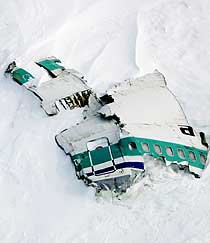 W
WIn aviation, a controlled flight into terrain is an accident in which an airworthy aircraft, under pilot control, is unintentionally flown into the ground, a mountain, a body of water or an obstacle. In a typical CFIT scenario, the crew is unaware of the impending disaster until it is too late. The term was coined by engineers at Boeing in the late 1970s.
 W
WDe-icing is the process of removing snow, ice or frost from a surface. Anti-icing is understood to be the application of chemicals that not only de-ice but also remain on a surface and continue to delay the reformation of ice for a certain period of time, or prevent adhesion of ice to make mechanical removal easier.
 W
WDissymmetry of lift in rotorcraft aerodynamics refers to an uneven amount of lift on opposite sides of the rotor disc. It is a phenomenon that affects single-rotor helicopters and autogyros in forward flight.
 W
WA helicopter is susceptible to a rolling tendency, called dynamic rollover, when close to the ground, especially when taking off or landing. For dynamic rollover to occur, some factor has to first cause the helicopter to roll or pivot around a skid, or landing gear wheel, until its critical rollover angle is reached. Then, beyond this point, main rotor thrust continues the roll and recovery is impossible. If the critical rollover angle is exceeded, the helicopter rolls on its side regardless of the cyclic control corrections made.
 W
WFlight envelope protection is a human machine interface extension of an aircraft's control system that prevents the pilot of an aircraft from making control commands that would force the aircraft to exceed its structural and aerodynamic operating limits. It is used in some form in all modern commercial fly-by-wire aircraft. The professed advantage of flight envelope protection systems is that they restrict a pilot's excessive control inputs, whether in surprise reaction to emergencies or otherwise, from translating into excessive flight control surface movements. Notionally, this allows pilots to react quickly to an emergency while blunting the effect of an excessive control input resulting from "startle," by electronically limiting excessive control surface movements that could over-stress the airframe and endanger the safety of the aircraft.
 W
WIn aviation and aerospace, foreign object damage (FOD), is any article or substance, alien to an aircraft or system, which could potentially cause damage.
 W
WA fume event occurs when bleed air used for cabin pressurization and air conditioning in a pressurized aircraft is contaminated by fluids such as engine oil, hydraulic fluid, anti-icing fluid, and other potentially hazardous chemicals.
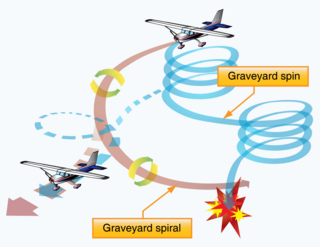 W
WIn aviation, a graveyard spiral is a type of dangerous spiral dive entered into accidentally by a pilot who is not trained or not proficient in instrument flight when flying in instrument meteorological conditions (IMC). Other names for this phenomenon include suicide spiral, deadly spiral, death spiral and vicious spiral.
 W
WIn aviation, a ground loop is a rapid rotation of a fixed-wing aircraft in the horizontal plane (yawing) while on the ground. Aerodynamic forces may cause the advancing wing to rise, which may then cause the other wingtip to touch the ground. In severe cases, the inside wing can dig in, causing the aircraft to swing violently or even cartwheel.
 W
WThe FAA states "The height–velocity diagram or H/V curve is a graph charting the safe/unsafe flight profiles relevant to a specific helicopter. As operation outside the safe area of the chart can be fatal in the event of a power or transmission failure it is sometimes referred to as the dead man's curve." The EASA refers to it as the "height/velocity avoid curve".
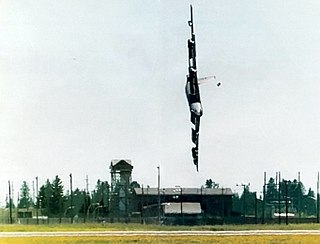 W
WPilot error generally refers to an accident in which an action or decision made by the pilot was the cause or a contributing factor that led to the accident, but also includes the pilot's failure to make a correct decision or take proper action. Errors are intentional actions that fail to achieve their intended outcomes. Chicago Convention defines accident as "An occurrence associated with the operation of an aircraft [...] in which [...] a person is fatally or seriously injured [...] except when the injuries are [...] inflicted by other persons." Hence the definition of the "pilot error" does not include deliberate crash.
 W
WPilot-induced oscillations, as defined by MIL-HDBK-1797A, are sustained or uncontrollable oscillations resulting from efforts of the pilot to control the aircraft and occurs when the pilot of an aircraft inadvertently commands an often increasing series of corrections in opposite directions, each an attempt to cover the aircraft's reaction to the previous input with an over correction in the opposite direction. An aircraft in such a condition can appear to be "porpoising" switching between upward and downward directions. As such it is a coupling of the frequency of the pilot's inputs and the aircraft's own frequency. During flight test, pilot-induced oscillation is one of the handling qualities factors that is analyzed, with the aircraft being graded by an established scale. In order to avoid any assumption that oscillation is necessarily the fault of the pilot, new terms have been suggested to replace pilot-induced oscillation. These include aircraft-pilot coupling, pilot–in-the-loop oscillations and pilot-assisted oscillations.
 W
WIn aerodynamics, pitch-up is an uncommanded nose-upwards rotation of an aircraft. It is an undesirable characteristic that has been observed mostly in experimental swept-wing aircraft at high subsonic Mach numbers or high angle of attack.
 W
WIn aviation, a propeller strike, or prop strike, also called a sudden stoppage, is an accident in which an aircraft's propeller contacts any object and is forcibly stopped or slowed. Propeller strikes can be the result of the propeller contacting the ground due to landing gear collapse, failure to extend the landing gear, or nose-over. However, the term also includes the damage incurred from contacting any object, such as a hangar door, or even the sudden rpm loss from contacting a yielding substance such as water or heavy tall grass.
 W
WA ramp strike or rampstrike is when an aircraft coming to land aboard an aircraft carrier impacts the rear of the carrier, also called the ramp, below the level of the flight deck.
 W
WA runway excursion is a runway safety incident where an aircraft makes an inappropriate exit from the runway. Runway excursions include runway overruns, where an aircraft is unable to stop before it reaches the end of the runway. Runway excursions can happen because of pilot error, poor weather, or a fault with the aircraft.
 W
WHuman senses are not naturally geared for the inflight environment. Pilots may experience disorientation and loss of perspective, creating illusions that range from false horizons to sensory conflict with instrument readings or the misjudging of altitude over water.
 W
WThe vortex ring state (VRS) is a dangerous aerodynamic condition that may arise in helicopter flight, when a vortex ring system engulfs the rotor causing severe loss of lift. Vortex ring state is sometimes referred to as settling with power, though the latter is also a terminology variously used for low-RPM states caused by rapid increases in collective resulting in over-pitching of the main rotor blades and/or from exceeding engine capability during rapid deceleration and/or descent. The Federal Aviation Administration (FAA) sees these terms as synonymous, whereas Transport Canada sees them as two different phenomena.
 W
WIn fluid dynamics, a stall is a reduction in the lift coefficient generated by a foil as angle of attack increases. This occurs when the critical angle of attack of the foil is exceeded. The critical angle of attack is typically about 15 degrees, but it may vary significantly depending on the fluid, foil, and Reynolds number.
 W
WA steep turn in aviation, performed by an aircraft, is a turn that involves a bank of more than 30 degrees. This means the angle created by the axis running along both wings and the horizon is more than 30 degrees. Generally, for training purposes, steep turns are demonstrated and practiced at 45 degrees, sometimes more. The purpose of learning and practicing a steep turn is to train a pilot to maintain control of an aircraft in cases of emergency such as structural damage, loss of power in one engine etc.
 W
WSuicide by pilot is an aviation disaster in which a certified or uncertified pilot deliberately crashes or attempts to crash an aircraft in a suicide attempt, sometimes to kill passengers on board or people on the ground. This is sometimes described as a murder–suicide. It is suspected as being a possible cause of the crashes of several commercial flights and is confirmed as the cause in others. Generally, it is difficult for crash investigators to determine the motives of the pilots, since they sometimes act deliberately to turn off recording devices or otherwise hinder future investigations. As a result, pilot suicide can be difficult to prove with certainty.
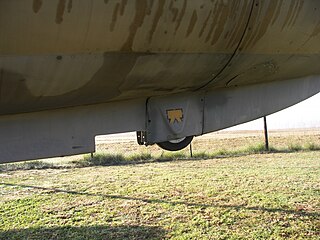 W
WIn aviation, a tailstrike or tail strike occurs when the tail or empennage of an aircraft strikes the ground or other stationary object. This can happen with a fixed-wing aircraft with tricycle undercarriage, in both takeoff where the pilot rotates the nose up too rapidly, or in landing where the pilot raises the nose too sharply during final approach, often in attempting to land too near the runway threshold. It can also happen during helicopter operations close to the ground, when the tail inadvertently strikes an obstacle.
 W
WA traffic collision avoidance system or traffic alert and collision avoidance system is an aircraft collision avoidance system designed to reduce the incidence of mid-air collisions between aircraft. It monitors the airspace around an aircraft for other aircraft equipped with a corresponding active transponder, independent of air traffic control, and warns pilots of the presence of other transponder-equipped aircraft which may present a threat of mid-air collision (MAC). It is a type of airborne collision avoidance system mandated by the International Civil Aviation Organization to be fitted to all aircraft with a maximum take-off mass (MTOM) of over 5,700 kg (12,600 lb) or authorized to carry more than 19 passengers. CFR 14, Ch I, part 135 requires that TCAS I be installed for aircraft with 10-30 passengers and TCAS II for aircraft with more than 30 passengers. ACAS/TCAS is based on secondary surveillance radar (SSR) transponder signals, but operates independently of ground-based equipment to provide advice to the pilot on potentially conflicting aircraft.
 W
WA turbine engine failure occurs when a turbine engine unexpectedly stops producing power due to a malfunction other than fuel exhaustion. It often applies for aircraft, but other turbine engines can fail, like ground-based turbines used in power plants or combined diesel and gas vessels and vehicles.
 W
WIn supersonic aerodynamics, unstart refers to a generally violent breakdown of the supersonic airflow. The phenomenon occurs when mass flow rate changes significantly within a duct. Avoiding unstarts is a key objective in design of the engine air intakes of supersonic aircraft which cruise at speeds of M2.2+.
 W
WHuman senses are not naturally geared for the inflight environment. Pilots may experience disorientation and loss of perspective, creating illusions that range from false horizons to sensory conflict with instrument readings or the misjudging of altitude over water.
 W
WPlumes of volcanic ash near active volcanoes are a flight safety hazard, especially for night flights. Volcanic ash is hard and abrasive, and can quickly cause significant wear to propellers and turbocompressor blades, and scratch cockpit windows, impairing visibility. The ash contaminates fuel and water systems, can jam gears, and make engines flameout. Its particles have low melting point, so they melt in the engines' combustion chamber then the ceramic mass sticks to turbine blades, fuel nozzles, and combustors—which can lead to total engine failure. Ash can also contaminate the cabin and damage avionics.
 W
WA vortex ring, also called a toroidal vortex, is a torus-shaped vortex in a fluid or gas; that is, a region where the fluid mostly spins around an imaginary axis line that forms a closed loop. The dominant flow in a vortex ring is said to be toroidal, more precisely poloidal.
 W
WWake turbulence is a disturbance in the atmosphere that forms behind an aircraft as it passes through the air. It includes various components, the most important of which are wingtip vortices and jetwash. Jetwash refers to the rapidly moving gases expelled from a jet engine; it is extremely turbulent, but of short duration. Wingtip vortices, however, are much more stable and can remain in the air for up to three minutes after the passage of an aircraft. It is therefore not true turbulence in the aerodynamic sense, as true turbulence would be chaotic. Instead, it refers to the similarity to atmospheric turbulence as experienced by an aircraft flying through this region of disturbed air.
 W
WWingtip vortices are circular patterns of rotating air left behind a wing as it generates lift. One wingtip vortex trails from the tip of each wing. Wingtip vortices are sometimes named trailing or lift-induced vortices because they also occur at points other than at the wing tips. Indeed, vorticity is trailed at any point on the wing where the lift varies span-wise ; it eventually rolls up into large vortices near the wingtip, at the edge of flap devices, or at other abrupt changes in wing planform.